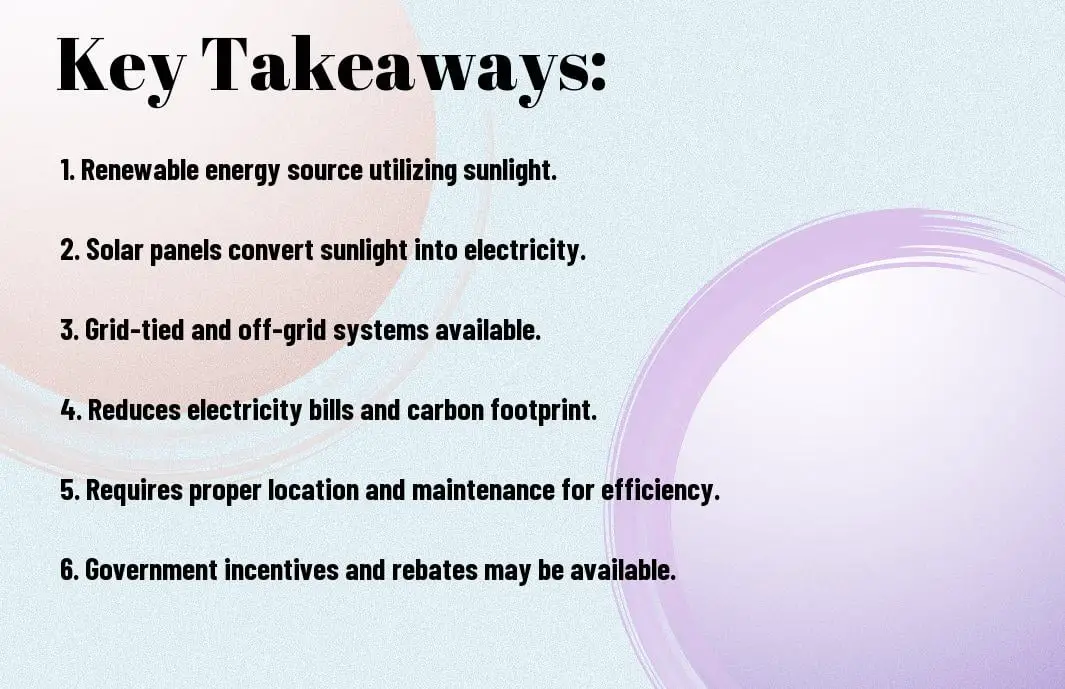Delve into the fascinating world of solar energy, a sustainable and renewable source of power that is revolutionizing the way we think about electricity production. Solar power harnesses the sun’s energy through photovoltaic panels, converting it into usable electricity for homes and businesses. This blog post will break down the fundamentals of solar energy, exploring its environmental benefits, cost-saving potential, and how it can contribute to a more sustainable future. Gain a deeper understanding of this powerful renewable energy source and how it can shape our world for the better.
Key Takeaways:
- Solar energy is renewable: Solar energy is generated from the sun, making it a sustainable and renewable source of power.
- Solar panels convert sunlight into electricity: Photovoltaic cells in solar panels convert sunlight into usable electricity through the photovoltaic effect.
- Solar energy is environmentally friendly: Solar energy produces no greenhouse gas emissions and helps reduce our reliance on fossil fuels, making it an environmentally friendly energy option.

The Science of Solar Energy
Obviously, solar energy is a renewable source of power that is derived from the sun’s radiation. This energy can be harnessed through various technologies to generate electricity, heat water, and provide lighting for homes and businesses.
Photovoltaic Effect Explained
An important concept to understand in the science of solar energy is the photovoltaic effect. This phenomenon occurs when photons from the sun strike a solar cell, causing electrons to be knocked loose. These electrons create an electrical current when captured, which can then be converted into usable electricity for powering various devices.
The efficiency of a solar panel in converting sunlight into electricity is crucial in maximizing the amount of energy produced. Advances in technology have led to higher efficiency rates, making solar power a more viable and sustainable option for meeting energy needs.
Components of a Solar Energy System
Effectively harnessing solar energy requires a combination of components, including solar panels, inverters, batteries, and a charge controller. Solar panels are the most visible component of a solar energy system, as they are responsible for capturing sunlight and converting it into electricity. Inverters are essential for converting the direct current (DC) electricity generated by the solar panels into alternating current (AC) electricity that can be used to power appliances and devices in homes.
Plus, batteries store excess electricity generated during the day for use at night or during periods of low sunlight. A charge controller regulates the flow of electricity from the solar panels to the batteries, ensuring they are not overcharged. Together, these components work seamlessly to provide a reliable and sustainable source of energy for residential and commercial applications.
Types of Solar Energy Systems
Despite the increasing popularity of solar energy systems, many people are still unaware of the different types available. Understanding the basics of solar energy systems can help individuals make informed decisions when considering solar power for their homes or businesses.
| Grid-Tied Systems | Off-Grid Systems |
| Cost-effective | Independent |
| Easy to install | Remote locations |
| Connected to the grid | No electricity bills |
| Net metering available | Battery storage required |
| Require little maintenance | Higher upfront costs |
Grid-Tied Systems
Any individual or organization looking to take advantage of solar energy without completely relying on it should consider a grid-tied system. These systems are connected to the local utility grid, allowing for a seamless transition between solar power and grid electricity. Grid-tied systems are typically more cost-effective and easier to install compared to off-grid systems.
Despite their advantages, grid-tied systems do have limitations. They do not provide power during grid outages, as they are designed to shut off for safety reasons. However, with net metering programs available in many areas, excess energy generated by the system can be fed back into the grid for credits on electricity bills.
Off-Grid Systems
Systems that are designed to operate independently from the grid are known as off-grid systems. These solar energy systems are ideal for remote locations where grid electricity is unavailable or too costly to install. Off-grid systems require battery storage to store excess energy generated during sunny days for use at night or during cloudy periods.
It is important to note that off-grid systems require careful planning and a larger upfront investment. Battery storage can be expensive and maintenance-intensive, but for individuals seeking complete energy independence and sustainability, off-grid systems provide a reliable solution.
Implementing Solar Energy
Assessing Solar Potential
Not all locations are equally suitable for harnessing solar energy. An important first step in implementing solar energy is assessing the solar potential of your site. Factors such as the amount of sunlight received throughout the year, shading from nearby buildings or trees, and the angle of the roof or ground where solar panels will be installed can all impact the efficiency of a solar energy system.
An assessment of solar potential typically involves a site visit by a professional solar installer, who will use tools such as solar path diagrams and shading analysis to determine the best location for solar panels. By understanding the solar potential of your site, you can optimize the design and placement of your solar energy system to maximize energy production.
Installation and Maintenance of Solar Panels
To ensure the effective operation of your solar energy system, proper installation and regular maintenance of solar panels are crucial. To install solar panels, a qualified professional will mount the panels securely on your roof or in an open area with optimal sunlight exposure. The panels need to be connected to an inverter that converts the direct current (DC) electricity produced by the panels into alternating current (AC) electricity used in your home.
To maintain the efficiency and longevity of your solar panels, regular inspections and cleaning are important. Dust, dirt, and debris can accumulate on the panels over time, reducing their ability to capture sunlight. Additionally, checking for any shading issues caused by new obstructions such as trees or buildings can help ensure your solar panels continue to operate at optimal performance levels.
Economic and Environmental Impact
Cost-Benefit Analysis
After installing a solar energy system, one of the key factors to consider is the cost-benefit analysis. While the initial investment of setting up solar panels can be significant, the long-term savings on energy bills can outweigh the upfront costs. It is essential to calculate the payback period for the initial investment and analyze the future savings to determine the overall financial impact.
Impact: Investing in solar energy can lead to reduced electricity costs over time, providing substantial savings in the long run. Additionally, many governments offer incentives, tax credits, and rebates for installing solar panels, further enhancing the financial benefits of switching to solar power.
Environmental Benefits and Considerations
With the increasing concern over climate change and environmental degradation, the environmental benefits of solar energy cannot be overstated. Solar power generates electricity without producing greenhouse gas emissions, reducing the reliance on fossil fuels and lowering the carbon footprint. By harnessing the power of the sun, we can move towards a cleaner, more sustainable future.
With technological advancements in solar energy systems, the efficiency of solar panels continues to improve, making them even more environmentally friendly. Additionally, solar energy helps in reducing air and water pollution, preserving natural resources, and protecting ecosystems for future generations.
The transition to solar energy is crucial for mitigating the impact of climate change and decreasing our dependence on finite resources. By embracing solar power, we can contribute to a healthier planet and create a more sustainable environment for all living beings.
Summing up
From above, it is evident that understanding the basics of solar energy is crucial for harnessing its potential and benefits. By grasping the concepts of how solar panels work, the types of solar systems available, and the advantages of solar energy, individuals can make informed decisions on adopting this renewable energy source. With a clear understanding of the fundamentals, one can contribute to a sustainable future by transitioning towards cleaner and more efficient energy solutions.
FAQ
Q: What is solar energy?
A: Solar energy is a renewable source of energy that is derived from the sun’s radiation. It can be converted into electricity or used for heating and cooling purposes.
Q: How does solar energy work?
A: Solar energy works by capturing sunlight through solar panels, which contain photovoltaic cells that convert sunlight into electricity. This electricity can then be used to power homes, businesses, and other applications.
Q: What are the benefits of solar energy?
A: Solar energy is a clean and sustainable source of power that reduces electricity bills, decreases reliance on fossil fuels, and helps combat climate change. It also requires minimal maintenance and can increase the value of a property.



